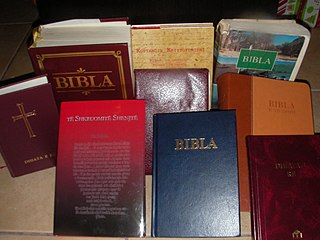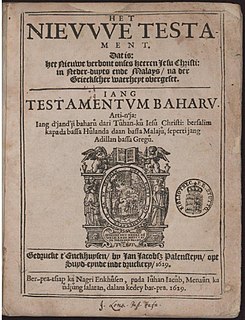Related Research Articles

The New Testament (NT) is the second division of the Christian biblical canon. It discusses the teachings and person of Jesus, as well as events in first-century Christianity. The New Testament's background, the first division of the Christian Bible, is called the Old Testament, which is based primarily upon the Hebrew Bible; together they are regarded as sacred scripture by Christians.

The New World Translation of the Holy Scriptures (NWT) is a translation of the Bible published by the Watch Tower Bible and Tract Society. The New Testament portion was released in 1950, as The New World Translation of the Christian Greek Scriptures, with the complete Bible released in 1961; it is used and distributed by Jehovah's Witnesses. Though it is not the first Bible to be published by the group, it is their first original translation of ancient Biblical Hebrew, Koine Greek, and Old Aramaic biblical texts. As of March 2, 2020, the Watch Tower Society has published more than 220 million copies of the New World Translation in whole or in part in 200 languages. Though commentators have said a scholarly effort went into the translation, critics have described it as biased.
Partial Bible translations into languages of the English people can be traced back to the late 7th century, including translations into Old and Middle English. More than 100 complete translations into English have been written.

In Christianity, the gospel or good news means a gift from God. It is the news which Christianity announces and that is the proclamation of the forgiveness of sins and fellowship with God restored through Christ. It means remission of sins and reconciliation with God through Christ's death by crucifixion. It is termed "the gospel of the grace of God", "the gospel of the kingdom", "the gospel of Christ", "the gospel of peace, "the glorious gospel," "the everlasting gospel," "the gospel of salvation". Christian theology describes the good news of salvation in Jesus Christ not as a new concept, but one that has been foretold throughout the Old Testament and was prophetically preached even at the time of the fall of man as contained in Genesis 3:14–15, which has been called the "Proto-Evangelion" or "Proto-Gospel".
The Institute for Bible Translation (IBT) was founded in Stockholm, Sweden in 1973 by the Bosnian-Croatian poet Borislav Arapović, its main task being to publish Bibles for "non-Slavic peoples in Slavic countries," not just Bible translations into the languages of Russia but also Central Asian languages.

Sacred Name Bibles are Bible translations that consistently use Hebraic forms of the God of Israel's personal name, instead of its English language translation, in both the Old and New Testaments. Some Bible versions, such as the Jerusalem Bible, employ the name Yahweh, a transliteration of the Hebrew tetragrammaton (YHWH), in the English text of the Old Testament, where traditional English versions have LORD.

The history of Bible translations into Albanian can be divided into early and modern translations.
The complete Bible has been translated into three of the dialects of Inupiat language, the New Testament in two more and portions in another.
While the Old Testament portion of the Bible was written in Hebrew, the New Testament was originally written in Koine Greek. The Greek language, however, has several different dialects or denominations. This required several different translations done by several different individuals and groups of people. These translations can be categorized into translations done before and after 1500 AD.
Work on translation of the Bible into the Kazakh language began with the work of Charles Fraser of the Scottish Missionary Society. Fraser's translation of Matthew was published in 1818, and the New Testament in 1820 by the Russian Bible Society. J. M. E. Gottwald, a professor at Kazan University, revised it, and this was published in 1880 by the British and Foreign Bible Society in Kazan, and it was republished in 1887, and 1910. George W. Hunter, of the China Inland Mission in Ürümqi, considered this translation to be "a good translation, into Astrahan-Turki", he does not seem to have considered it to be Kazakh. Darlow and Moule say that it was intended for Kyrgyz in the neighbourhood of Orenburg, and the language was sometimes called "Orenburg Tatar". According to Rev. W. Nicholson of the Royal Asiatic Society in St Petersburg this translation was intended for "The Kirghese hordes—Great, Little, and Middle, as they are called—[who] occupy various regions in Southern Siberia, Central Asia, and west of the Caspian Sea." George A. King says Fraser's translation was into the language of the "Western Kirghiz or Kirghiz-Kazak, though they disown the name Kirghiz".
The earliest known Christian texts in Old Uyghur are known from manuscript fragments uncovered in the Turfan oasis. There are approximately fifty fragments written in Old Uyghur. An early Uyghur translation of the New Testament and the Psalms may have been done in the 14th century by Giovanni da Montecorvino, papal envoy to the Mongols who became Roman Catholic archbishop of Khanbaliq in 1307.
Part of the Bible was first available in the Kurdish language in 1856. Modern translations of the whole Bible are available in standard Kurmanji and Sorani, with many portions in other dialects.
The history of Bible translation into the Berber language is fairly recent. The six major Berber language/dialects are spoken by 90% of the total Berber-speaking population: Tashelhit Berber, Kabyle Berber, Central Atlas Tamazight, Riffian Berber, Shawiya Berber, and Tuareg Berber.
Bible translations into Oceanic languages have a relatively closely related and recent history.
Biblical translations into the indigenous languages of North and South America have been produced since the 16th century.

The Athabaskan language family is divided into the Northern Athabaskan, Pacific Coast Athabaskan and Southern Athabaskan groups. The full Bible has been translated into two Athabaskan languages, and the complete New Testament in five more. Another five have portions of the Bible translated into them. There are no Pacific Coast Athabaskan languages with portions of the Bible translated into them.

Bible translations into the languages of Indonesia and Malaysia have a lot of common history up until the modern era. Apart from the shared Malay language which historically was the lingua franca of the Malay archipelago and forms the basis for the national languages of Indonesia and Malaysia today, portions of the Bible have been translated into a variety of indigenous languages in the region.
The Bible, or portions of it, have been translated into over 1,000 languages of Africa. Many of these are indexed by the Forum of Bible Agencies, Find.Bible site and available online in text and audio form, as print on demand versions, or through churches and book sellers. This effort continues. Not all are (yet) listed below.
Traditionally Russia used the Old Church Slavonic language and Slavonic Bible, and in the modern era Bible translations into Russian. The minority languages of Russia usually have a much more recent history, many of them having been commissioned or updated by the Institute for Bible Translation.
The first portion of the Bible, the Gospel of John, in a Tibetic language was translated by Moravian Church missionaries William Heyde, Edward Pagel, and Heinrich August Jäschke, and later Dr. August Francke. It was printed in 1862 at Kyelang capital of Lahul in Kashmir. The whole New Testament was printed in 1885 in Ladakh. Another version was translated in 1903. So as not to have the problem of various dialectal differences it was translated into classical Tibetan, but this was not understood by most people. Yoseb Gergen, a Tibetan Christian translated the entire Bible, complete in 1935. This version was translated into a dialect of Tibetan Gergen had accidentally stumbled across, and which was understandable by all Tibetans. It was finally published in 1948. This is known in India as the Tibetan OV Bible. Eliya Tsetan Phuntshog published a New Testament in 1970. There is currently a project going on to translate the Bible into the East Tibetan dialect.
References
- ↑ "World Scriptures - Uzbek" . Retrieved 2009-09-08.
- ↑ "About the Bible Society of Uzbekistan".